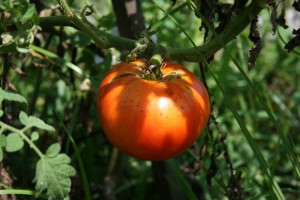My tomato seedlings nearly died today and it wasn’t because of the cats. Like many gardeners, I moved my seedlings out from under the plant lights in the house to the outdoors to harden them off. The process of hardening off seedlings is an important step when growing plants from seed for the outdoor garden. Inside, plants are coddled. Light and temperature are closely regulated; a timer makes sure my seedlings receive 14 hours of daylight every day, and the temperature never varies from around 65 (a bit cold, but okay.)
Wind, however, is something for which my seedlings are ill-prepared. Wind stimulates transpiration, or the process by which plants excrete water through their leaves. Combine this with wind drying out the soil is my plant flats and you’ll understand why I was in a bit of a panic when my husband called me downstairs to ask if he should bring the flats of seedlings into the garage.
The wind today is fierce, more like a March day than a late April day. I’ve had to close the windows in the office because the shrieking wind is so loud I can barely hear myself think. Wind helps plants develop stronger stems and encourages certain cells within the plants to respond, making the plant stronger, but in this case I think the gale outside was doing more harm than good!
Wind affects plants in many ways. In addition to increasing water loss, it also helps with pollination for some plants. I’ll skip the pollination today and just save my tomatoes for another day. I think I lost one and perhaps a basil seedling, but some will make it, and after all, how many tomatoes can two people eat?
A lot. Maybe I should plant more….





